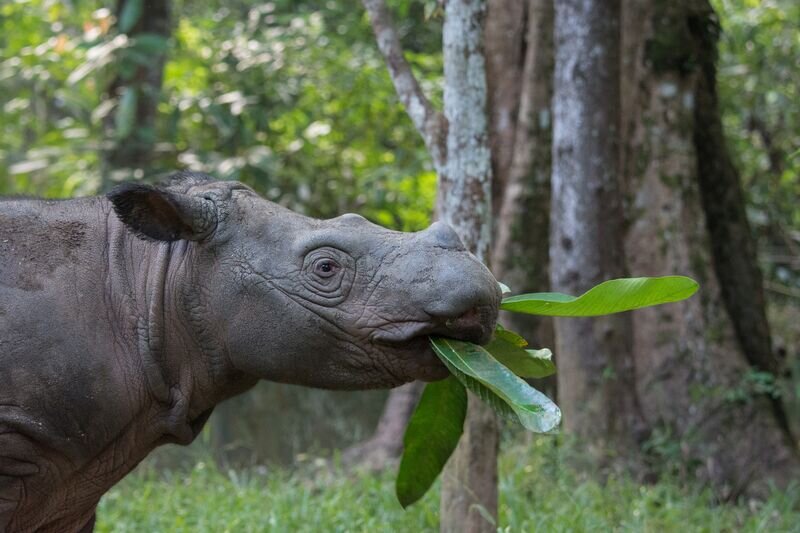Preparing for A Rhino Rescue Mission
Inside the Bold Project to Capture and Breed Sumatran Rhinos in Indonesia
Though the project has been temporarily delayed due to COVID-19, the international team of experts hopes to be able to start capturing rhinos in early 2021. Photo Credit: Courtesy Global Wildlife Conservation
In the dense tropical forests of Sumatra, four teams of conservationists comb through sections of forest looking for subtle, but distinct signs of some of the rarest animals on the planet. Their trained eyes are looking for twisted branches, footprints with three toes, or fresh dung. All are telltale signs of the presence of a Sumatran rhino.
The teams are in the early stages of a bold mission to capture Sumatran rhinos and move them to a Sumatran Rhino Sanctuary in support of the Government of Indonesia’s national Sumatran rhino breeding program that aims to safeguard the species from extinction. If the teams are successful, the project’s legacy will be future generations of rhinos that will one day return to the forests of Sumatra.
Though the project has been temporarily delayed due to COVID-19, the international team of experts hopes to be able to start capturing rhinos in early 2021.
“First we have to find them, which is harder than you would think, so we have been conducting surveys over the last year,” explains Barney Long, senior director of species conservation for Global Wildlife Conservation, which is a member of the Sumatran Rhino Survival Alliance. “It’s difficult and it takes months to get all of this data together.”
In order to find rhinos, the teams are conducting surveys, which are like meticulous games of hide-and-seek. They search small grid cells of forest that are 4 kilometers by 4 kilometers. They comb through the block and if after searching nearly every inch of it, they don’t find a rhino, they can black that grid out on their master map and move on to search the next.
If teams do find signs of a rhino, then they transition from a detection survey to a trajectory survey. During a trajectory survey, a team will track a rhino and learn the trails it’s using, including the places it likes to visit, like wallows and salt licks. They will also put up camera traps to learn as much about the individual rhino as they can such as gender, age group, and health condition. That sets the stage for the next phase of the rhino rescue mission: moving the rhino to a Sumatran Rhino Sanctuary.
Jeff Holland, Sumatran Rhino Senior Advisor for Training, Husbandry and Capture at the International Union for Conservation of Nature’s Species Survival Commissions (IUCN SSC), will work with an Indonesian capture coordinator, veterinary team, and local logistics team on the ground in Sumatra to catch the rhinos. Together, they will build the traps for capturing rhinos.
“It’s a lot of back work,” explains Holland. “The traps are about 12 feet long 4 feet wide and about six feet deep and that's literally dug on a forest trail and can take anywhere from two to three weeks depending on the condition of the soil and the terrain.”
After the capture teams have dug the traps, they wait. It can take weeks or months for a rhino to enter the trap. But whenever it happens, the capture team will be ready. They will have a camp nearby that is staffed 24 hours-a-day, seven-days-a-week. Every day they will check the trap for a rhino.
When the capture team has caught a rhino, they will quickly move it to a boma, a large circular paddock in the forest. The capture and veterinary teams will ensure the rhino is safe, healthy, has plenty of food and water and is disturbed as little as possible.
Holland will help organize logistics for moving captured rhinos from the bomas to a Sumatran Rhino Sanctuary. The team may carefully move a rhino in a crate to a main road where it can be driven to a Sanctuary. If the boma is in a deep and inaccessible part of the forest, they may need to airlift the rhino out using a helicopter.
“A lot of it's going to be dependent on the location of where the trap is set, where the rhino’s captured and the weather,” explains Holland. “Using a helicopter, it's a lot quicker and allows us to operate in more remote locations. But you need to have a backup to be able to get them out by ground. So, we'll have contingencies for both.”
In the coming months, the international team will prepare for the captures. They will undergo training and extensive assessments to ensure they are ready to capture and move such precious cargo. The assessments will make sure they have the necessary skills, safety protocols, emergency protocols and backup emergency protocols in place to make a capture successful.
“And we will not allow a capture to happen until we're satisfied that the logistics are sorted, the capacity and training has all been done and all of the protocols are there,” says Long.
If everything goes according to plan, in the future there will be many healthy Sumatran rhinos ready to return to the forest.
“I would like to see a large number of them in a forest and breeding,” says Holland. “If we’re successful here and get the breeding going, hopefully one day we’ll get them back into the forest. That’s the ideal situation. That's what the whole ultimate goal is.”

